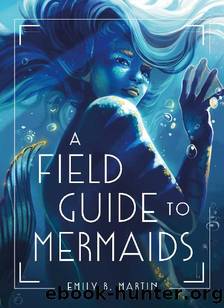A Field Guide to Mermaids by Emily B. Martin

Author:Emily B. Martin [Martin, Emily B.]
Language: eng
Format: epub
Publisher: Henry Holt and Co. (BYR)
Published: 0101-01-01T00:00:00+00:00
FREEZING WETLAND MERMAIDS
Prairie Potholes, SD
Mermaids in rivers or lakes have options for survival when winter freezes hit, but what do mermaids in wetlands do? Some, perhaps, can migrate or shelter in deep water, but some only have access to shallow pools and wet meadows. In the Prairie Pothole Region of the Dakotas, for example, there are thousands of glacier-carved ponds, but theyâre often surrounded by wide grasslands. What do mermaids do when these freeze over?
Something amazing, it turns out. Mermaids in these freezing wetlands have adapted with the incredible ability to freeze solid but not die. When winter comes, much like their estivating cousins in floodplain forests, they settle down under some nice mud and let their bodies freeze. Their heartbeats and breathing slow and then stop, and ice forms in their blood and around their internal organs. While this would kill most animals, their bodies produce high amounts of sugar that acts as a kind of âantifreezeâ for their cells, keeping them alive. As spring arrives, they thaw and head back out into their favorite pools, good as new.
CREATURE FEATURE
Wood FrogsâThese incredible frogs are masters of cold environments and are the only frog found above the Arctic Circle. When frozen, they appear like rock-solid, frog-shaped statues. In the coldest parts of their range, they can survive temperatures as low as -50 degrees Fahrenheit and can freeze for up to eight months!
Download
This site does not store any files on its server. We only index and link to content provided by other sites. Please contact the content providers to delete copyright contents if any and email us, we'll remove relevant links or contents immediately.
| African | Anthologies |
| Arthurian | Asian |
| Collections | Dragons |
| European | Greek & Roman |
| Latin American | Mermaids |
| Multicultural | Norse |
| Other | United States |
Quests for Glory by Soman Chainani(7096)
Shadow and Bone by Leigh Bardugo(6682)
Percy Jackson 1 - The Lightning Thief by Riordan Rick(4875)
Siege and Storm by Leigh Bardugo(4856)
The School for Good and Evil #2: A World without Princes by Chainani Soman(4091)
The miraculous journey of Edward Tulane by Kate DiCamillo(4070)
The Dark Prophecy by Rick Riordan(3159)
Flame in the Mist by Renée Ahdieh(3065)
Quidditch Through the Ages by J.K. Rowling(3061)
Cress by Marissa Meyer(2849)
Fairy Mom and Me by Sophie Kinsella(2845)
The Little Prince by Antoine de Saint-Exupéry(2826)
Quidditch through the Ages by J. K. Rowling(2768)
Quidditch Through The Ages by J. K. Rowling(2728)
The Tales of Beedle the Bard (Flyboy707Jerry eBooks) by J. K. Rowling(2718)
Mythology: Timeless Tales of Gods and Heroes by Edith Hamilton & Jim Tierney & Jim Tierney(2710)
The Tales of Beedle the Bard by Rowling J. K(2638)
The Tales of Beedle the Bard by J. K. Rowling(2565)
The Fowl Twins by Eoin Colfer(2556)
